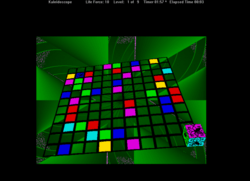Endorfun
| Endorfun | |
|---|---|
 | |
| Developer(s) | Onesong Partners |
| Publisher(s) | Time Warner Interactive |
| Designer(s) | Michael Jai Feinberg |
| Platform(s) | PC, Mac OS |
| Release date(s) | 1995 |
| Genre(s) | Arcade |
| Mode(s) | Single player |
Endorfun is a single-player, arcade-style computer game released in 1995. It uses new age messages throughout its soundtrack.
Gameplay
The player controls a small cube, referred to as a light body, by using the keyboard or mouse. The light body rolls along a grid (the unified field) collecting life force tiles (coloured tiles with a texture matching that of the cube) by rolling the cube over them such that the top face of the cube matches the colour of the tile. Coloured tiles of varying types appear randomly on the playing surface, but can be eliminated in the same manner as life force tiles.
Games are divided into multiple levels, each of which has a set time limit and a life force target. If a player collects the target amount of life force play proceeds to the next level. If the timer expires or the light body is unable to move (all adjacent grid spaces are blocked by coloured tiles) then the game is over.
There are three different modes of play in Endorfun, each with different goals:
- Longevity: play for the longest possible time
- Abundance: pass through a set number of levels before time runs out
- Quickening: as Abundance, but levels become progressively faster and more difficult
Soundtrack
Endorfun's soundtrack is composed of a large number of short, looped song segments. Each segment is approximately 5 seconds long, with different segments strung together to provide longer, varied soundtracks for each level.
Each level's soundtrack contains messages oriented towards peace, well-being, love, and happiness.
Reception
Reviewing the Macintosh version, a Next Generation critic lauded the gameplay, saying it "soon becomes a Zen sort of experience in the same way that Tetris sometimes does". He added that the "abstract symphony of mesmerising graphics, colorful motion, and swelling, jazzy background tunes soon puts the player in that autopilot gaming state where complex movement sequences and on-the-fly strategies becomes second nature and all is forgotten but the rhythm." Despite this, he gave it only three out of five stars.[1]
See also
- Cu-On-Pa, a similar game released in Japan for the Super Famicom and PlayStation under license from Onesong Partners, Inc.
References
- ↑ "Endorfun". Next Generation. Imagine Media (12): 192,195. December 1995.